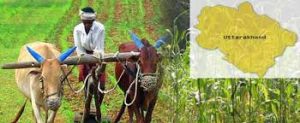
Uttarakhand totally dependend on agriculture more than 4/5 of the working population is directly engaged in agriculture.Doon valley ,nainital district,udham singh nagar and haridwar produce large quantities of food grains.it has immense potential for the development of horticulture cross-apple,orange , malta , pear , grapes , peach, plum apricot, litchi , mango ,guava etc are widely produced fruits.
Other important occupations include forestry,sheep rearing and livestock farming and household or cottage industries.
Agriculture takes place in the river valleys of uttarakhand,several slops have been shaped into field terraces, a common trend in mountain agriculture everywhere.the uttarakhand farmer have also developed advanced manure,crop rotation and inter-cropping practices . most land along the slopes remains unirrigated.
Three types of agriculture are these river valley :-
Katil ( forest edge land): hoe cultivation,rotation of 3 crops in 5 years , important crops:- millets , amaranth
Upraon ( hillside land) : always terraced , but unirrigated , important crops :- mandua , jhangora , chaulai .
Talaon ( valley bottom land) : paddy cultivation , low-lying , irrigated , double cropped . important crops :- wheat , rice, sugarcane etc.
Ecological sub–region altitude (m) chief crops
Lower dun,terai 300-600 wheat, rice , sugarcane
Upper dun , bhabar , lower shivaliks 600-1,200 wheat , rice , mandua , jhangora
, chaulai , maize.
Middle garhwal-kumaon 1,200-1,800 wheat , rice , mandua , jhangora
,‖ cheena‖ ,potato , barley
Upper garhwal-kumaon 1,800-2,400 wheat , barley , potao , chaulai ,
cheena , ― phaphra ―
Cold zone 2,400-3,600 wheat , barley , potato ,
phaphra , chaulai , kauni ,ogal
different pulses are inter-cropped during the two harvest periods :-
early winter after the rainy season (millet)
midsummer before the hot dry season ( barley-wheat)
dry and wet rice , taro , pumpkins , beans , corn , ginger , chill , cucumbers , leafy vegetables and tobacco are also cultivated.potatoes
have developed into a principal cash crop growing in areas unpropitious for other plants.
Conventional Himalayan agriculture is being destroyed by market stresses,introducing both economic and cultural modifications in uttarakhand. Ancient self-sufficiency has been replaced by dependency on imports from the plains , with their pesticide or chemical fertilizer-enhanced products . cultural domination from the plains also poses a threat to the usual foods as an Conventional Himalayan agriculture is being destroyed by market stresses,introducing both economic and cultural modifications in uttarakhand. Ancient self-sufficiency has been replaced by dependency on imports from the plains , with their pesticide or chemical fertilizer-enhanced products . cultural domination from the plains also poses a threat to the usual foods as an increasing preference for mill-polished rice is triumphing over mountain crops.
LAND DISTRIBUTION
The pattern of land ownership is unlike that found in the rest of india.most uttarakhand farmers are owner-cultivators.tenant farming and sharecropping are rare , and landholding generally small and limited to family farms .the zamindari system of big landholders is limited to the plains . both geography and pahari cultural heritage has played a role in maintaining traditionally more equitable , if impoverished , land distribution in uttarakhand.
- UKPCS Mains Tests and Notes Program
- UKPCS Prelims Exam 2024- Test Series and Notes Program
- UKPCS Prelims and Mains Tests Series and Notes Program
- UKPCS Detailed Complete Prelims Notes
